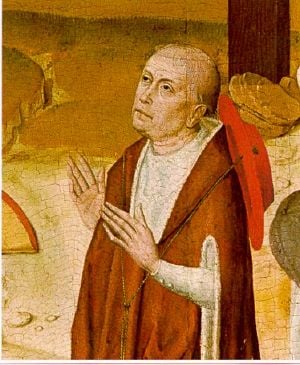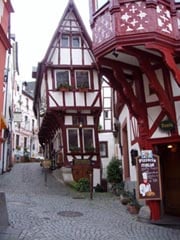Nicholas of Cusa
Nicholas of Cusa (born 1401 in Bernkastel-Kues, Germany – August 11, 1464 in Todi) was a German cardinal of the Catholic Church, a philosopher, jurist, mathematician, and an astronomer. He is widely considered as one of the greatest geniuses and polymaths of the 15th century. He is also referred to as Nicolaus Cusanus and Nicholas of Kues.
He was born Nikolaus Krebs in Kues (latinized as "Cusa") to a merchant family, and received his doctorate in Canon law from the University of Padua in 1423.
After a successful career as a papal legate, he was made a cardinal by Pope Nicholas V in 1448 or 1449, and was named Bishop of Brixen in 1450. His work as bishop was opposed by Duke Sigismund of Austria; the duke imprisoned Nicholas in 1460, for which Pope Pius II excommunicated Sigismund and laid an interdict on his lands. Nicholas of Cusa was never able to return to his bishopric, however: Sigmund's capitulation in 1464 came a few days after Nicholas's death at Todi in Umbria.
Nicholas of Cusa was noted for his deeply mystical writings about Christianity, particularly the nature of the Trinity. Many believe he was influenced in this by the work of Thomas a Kempis. He was suspected by some of holding pantheistic beliefs, but his writings were never accused as being heretical. Most of his mystical ideas can be found in his essays, De Docta Ignorantia (Of Learned Ignorance) and De Visione Dei (Vision of God).
Nicholas is also considered by many to be a genius ahead of his time in the field of science. Predating Copernicus by half a century, Nicholas suggested that the earth was a nearly spherical shape that revolved around the Sun, and that each star is itself a distant sun. He was not, however, describing a scientifically verifiable theory of the universe: his beliefs (which proved uncannily accurate) were based almost entirely on his own personal speculations and numerological calculations. He made important contributions to the field of mathematics by developing the concepts of the infinitesimal and of relative motion. Cusanus was the first to use concave lenses to correct myopia.
In 1433, he proposed a method to elect Holy Roman Emperors that, while it was not adopted by the Church, was essentially the same method known today as the Borda count, which is used in many academic institutions, competitions, and even some political jurisdictions, in original form and a number of variations. His proposal preceded Borda's work by over three centuries.
Upon his death, his body was interred in the church of San Pietro in Vincoli in Rome, but was later lost. In accordance with his wishes, his heart is within the chapel altar at the Cusanusstift in Kues. To this charitable institution that he had founded he bequeathed his entire inheritance: it still stands, and serves the purpose Nicholas intended for it, as a home for the aged. The Cusanusstift houses also many of his manuscripts.
External links
- Translations of numerous philosophical and theological treatises
- Bernkastel-Kues tribute to Nikolaus von Kues
- A biography of Nicholas of Cusa
- MacTutor biography, focusing on mathematical achievements
- Catholic Encyclopedia article on Nicholas of Cusa
- Website of the Cusanusstift (in German)
de:Nikolaus von Kues fr:Nicolas de Cues hr:Nikola Kuzanski it:Nicola Cusano la:Nicolaus Cusanus lt:Nikolajus Kuzietis nl:Nicolaus Cusanus ja:ニコラウス・クザーヌス no:Nikolaus av Cusa pl:Mikołaj z Kuzy ro:Nicolaus Cusanus ru:Николай Кузанский sk:Mikuláš Kuzánsky fi:Nicolaus Cusanus sv:Nicolaus Cusanus
Credits
New World Encyclopedia writers and editors rewrote and completed the Wikipedia article in accordance with New World Encyclopedia standards. This article abides by terms of the Creative Commons CC-by-sa 3.0 License (CC-by-sa), which may be used and disseminated with proper attribution. Credit is due under the terms of this license that can reference both the New World Encyclopedia contributors and the selfless volunteer contributors of the Wikimedia Foundation. To cite this article click here for a list of acceptable citing formats.The history of earlier contributions by wikipedians is accessible to researchers here:
The history of this article since it was imported to New World Encyclopedia:
Note: Some restrictions may apply to use of individual images which are separately licensed.

